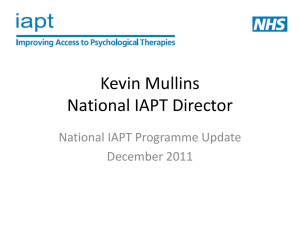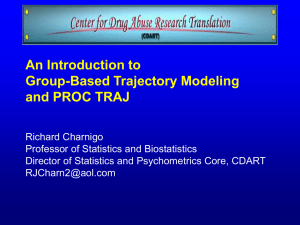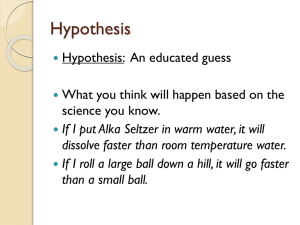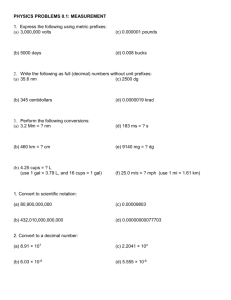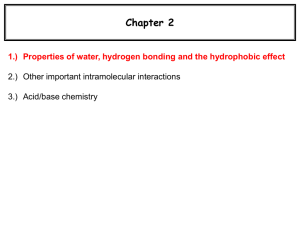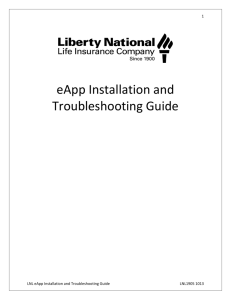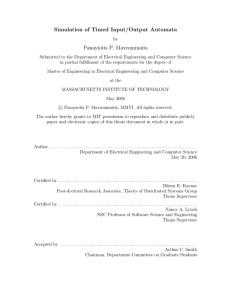JCC_21628_sm_suppinfo
advertisement
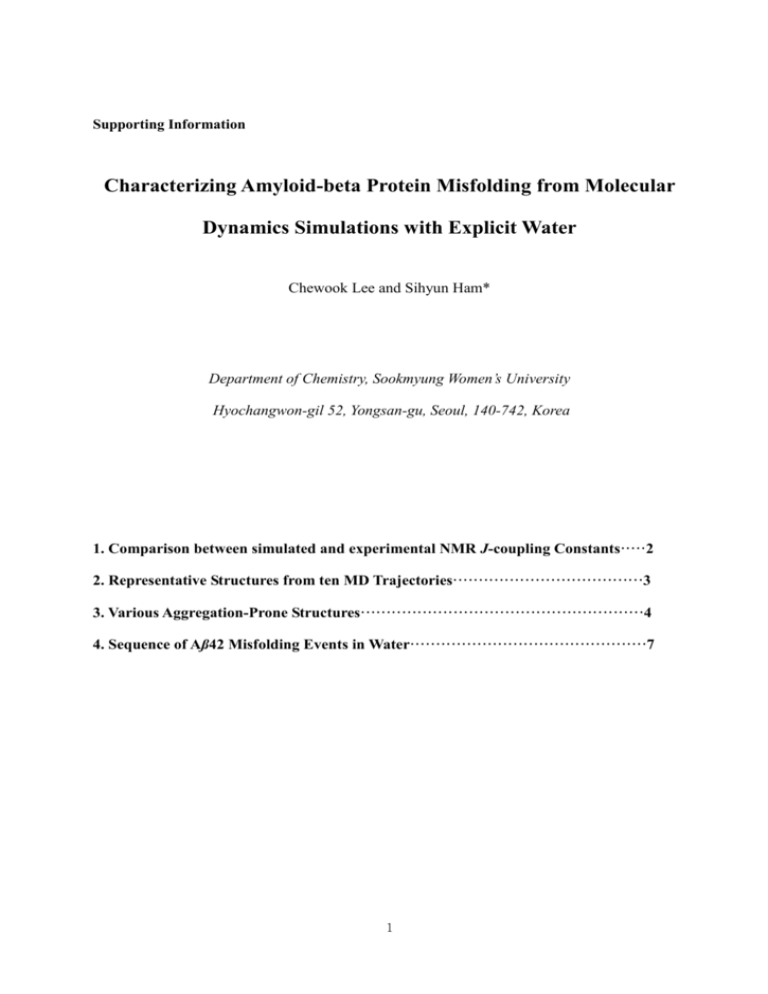
Supporting Information Characterizing Amyloid-beta Protein Misfolding from Molecular Dynamics Simulations with Explicit Water Chewook Lee and Sihyun Ham* Department of Chemistry, Sookmyung Women’s University Hyochangwon-gil 52, Yongsan-gu, Seoul, 140-742, Korea 1. Comparison between simulated and experimental NMR J-coupling Constants·····2 2. Representative Structures from ten MD Trajectories·····································3 3. Various Aggregation-Prone Structures·······················································4 4. Sequence of Aß42 Misfolding Events in Water··············································7 1 1. Comparison between Simulated and Experimental NMR J-coupling Constants Figure S1. Computed three bonds (HN-N-C-H) J-coupling constants (filled circle) from MD simulations are compared with the NMR experimental values (open circle) from Ref. 51. Computed values were obtained based on the selected ten clusters sampled by the clustering analysis for 500 ns MD trajectories. The average value of the calculated J-coupling constants for Aß42 is 6.65 with a standard deviation of 0.94. The average value of the reported experimental J-coupling constants is 6.80 with a standard deviation of 0.74. We also calculated the Pearson’s correlation coefficient (PCC), i.e. the absolute deviation from experimental values over the sum of errors to evaluate the correlation between the calculated and experimental J-coupling constant values. The calculated PCC value based on our simulation results is 0.39. Previously reported PCC value for Aß42 in the Ref. 51 is 0.43 using OPLS force field. Nevertheless, the force field used for these simulations qualitatively reproduces the experimentally determined NMR J-coupling constants but somewhat underestimate the values of J-coupling constants, which is in agreement with the previous observation. 2 2. Representative Structures from Ten MD Trajectories Traj. A Traj. B Traj. C Traj. D Traj. E Traj. F Traj. G Traj. H Traj. I Traj. J Figure S2. The most populated structures for Aß42 in water obtained from ten independent trajectories. Each structure is the closest one to the centroid of the largest conformational cluster. The structures are color-coded according to sequence, ranging from blue to red at the N- and C-termini, respectively. 3 3. Various Aggregation-Prone Structures Table S1. Various structural factors of aggregation-prone structures. # of Structure C RMSDa Radius of Gyrationb SASAc Variation C Contactd Nonlocal Backbone Contacth 1 8.653 11.994 18.37 59.45 20.19 10.385 20.967 59.56 (0.373) (0.168) (5.41) (3.06) (2.83) (0.316) (1.496) (7.97) 2 8.854 11.976 20.34 60.21 18.75 10.428 21.431 50.21 (0.337) (0.180) (6.39) (3.18) (2.11) (0.362) (1.358) (17.48) 3 11.136 11.177 5.76 55.16 19.24 9.001 15.115 28.55 (0.267) (0.166) (5.60) (4.76) (3.74) (0.277) (2.108) (13.60) 4 10.242 10.447 12.04 62.92 23.55 11.391 22.137 25.13 (0.166) (0.124) (5.66) (3.51) (2.02) (0.322) (1.839) (5.52) 5 10.312 10.652 10.23 57.97 24.61 12.242 21.879 7.62 (0.239) (0.152) (6.30) (3.21) (1.82) (0.367) (1.792) (5.20) 6 10.997 10.484 13.52 64.67 20.69 11.241 19.730 25.78 (0.236) (0.201) (5.21) (2.59) (1.61) (0.208) (1.107) (4.07) 7 11.360 9.718 6.29 59.66 15.39 8.612 18.435 60.28 (0.127) (0.077) (5.12) (2.98) (1.25) (0.290) (0.903) (13.12) 8 11.233 9.797 6.64 55.37 14.99 8.863 18.689 44.41 (0.127) (0.109) (5.59) (4.23) (1.79) (0.345) (1.278) (16.96) Av. 10.348 10.781 11.65 59.43 19.68 10.270 19.798 37.69 (0.234) (0.147) (5.66) (2.15) (2.15) (0.311) (1.485) (10.49) a) Root-mean-square deviation of C atoms of 42 residues (unit: Å), b) unit : Å, c) variation of solvent accessible surface area (SASA) for hydrophobic residues with respect to the initial structure, (water probe: 1.4 Å, unit: %), d) number of contact between Cα atoms within 6.5 Å, e) number of hydrophobic contacts between residues within 5.4 Å, (hydrophobic residues are listed in the subsection, Trajectory analysis), f) the distance between the center of mass of Aß(17-26) and Aß(33-42) (unit: Å), g) end-to-end distance between Cα atoms in both termini. (unit: Å), h) nonlocal backbone heavy atom contact within 5.4 Å between Aß(15-25) and Aß(32-42). 4 Tertiary Contacte HP core Distancef End-to-End Distanceg 1 2 3 4 5 6 7 8 Figure S3. Various aggregation-prone structures for A42 in water. The structures are color-coded according to sequence, ranging from blue to red at the N- and C-termini, respectively. 5 1 2 3 4 5 6 7 8 Figure S4. Average contact maps of eight aggregation-prone structures of Aß42 which are corresponded to the structures in Figure S3, respectively. Black dot denotes the distance between two closest heavy atoms of the two residues is within 3.0 Å and white area represents the distance over 7.0 Å. Values in between are shown with increasing levels of gray. Backbone contacts are shown in leftupper side and side chain contacts are shown in right-lower side in each figure. 6 4. Sequence of Aß42 Misfolding Events in Water Figure S5. Sequence of hierarchical events of Aß42 monomer misfolding: 0 ns: initial helix-kink-helix, 2 ns and 7 ns: hydrophobic C-terminal fluctuation, 18 ns: loop formation (res. 25-29) and 24 ns: central hydrophobic core regions (res. 17-21) and Cterminal region (res. 38-42) get closer and nonlocal backbone contact are formed, 43 ns: the number of nonlocal backbone contact gets increased, and the hydrophobic solvent accessible surface area gets increased, and 50 ns: tight backbone H-bonding formation is observed. The structures are color-coded according to sequence, ranging from blue to red at the N- and C-termini, respectively. -7-
